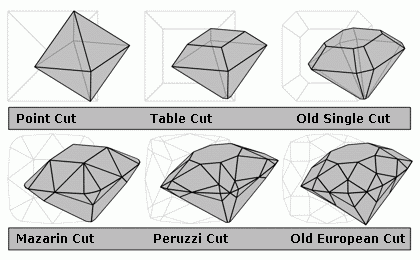Diamond cutting is the art and science of creating a gem-quality diamond out of mined rough. The cut of a diamond describes the manner in which a diamond has been shaped and polished from its beginning form as a rough stone to its final gem proportions. The cut of a diamond describes the quality of workmanship and the angles to which a diamond is cut. Often diamond cut is confused with "shape".
There are mathematical guidelines for the angles and length ratios at which the diamond is supposed to be cut in order to reflect the maximum amount of light. Round brilliant diamonds, the most common, are guided by these specific guidelines, though fancy cut stones are not able to be as accurately guided by mathematical specifics.
The techniques for cutting diamonds have been developed over hundreds of years, with perhaps the greatest achievements made in 1919 by mathematician and gem enthusiast Marcel Tolkowsky. He developed the round brilliant cut by calculating the ideal shape to return and scatter light when a diamond is viewed from above. The modern round brilliant has 57 facets (polished faces), counting 33 on the crown (the top half), and 24 on the pavilion (the lower half). The girdle is the thin middle part. The function of the crown is to diffuse light into various colors and the pavilion's function to reflect light back through the top of the diamond.
The culet is the tiny point or facet at the bottom of the diamond. This should be a negligible diameter, otherwise light leaks out of the bottom. Tolkowsky's ideal dimensions did not include a culet. However, a thin culet is required in reality in order to prevent the diamond from easily chipping in the setting. A normal culet should be about 1%–2% of the overall diameter.
 The further the diamond's characteristics are from Tolkowsky's ideal, the less light will be reflected. However, there is a small range in which the diamond can be considered "ideal." Today, because of the relative importance of carat weight in society, many diamonds are often intentionally cut poorly to increase carat weight. There is a financial premium for a diamond that weighs the magical 1.0 carat, so often the girdle is made thicker or the depth is increased. Neither of these tactics make the diamond appear any bigger, and they greatly reduce the sparkle of the diamond. So a poorly cut 1.0 carat diamond may have the same diameter and appear as large as a 0.85 carat diamond.Ideal cuts can be controversial as the definitions of brilliance and beauty are very subjective.
Tolkowsky's mathematical model is now superseded by the GIA Facetware software that is the culmination of 20 years of studies on diamond cuts.
New diamond cuts are now all the rage in the diamond industry as for example a design invented in 2003 and called the Genesis cut. This cut differs in shape from the more traditional cuts in its concave surfaces and angles and resembles a 4-pointed star.
The further the diamond's characteristics are from Tolkowsky's ideal, the less light will be reflected. However, there is a small range in which the diamond can be considered "ideal." Today, because of the relative importance of carat weight in society, many diamonds are often intentionally cut poorly to increase carat weight. There is a financial premium for a diamond that weighs the magical 1.0 carat, so often the girdle is made thicker or the depth is increased. Neither of these tactics make the diamond appear any bigger, and they greatly reduce the sparkle of the diamond. So a poorly cut 1.0 carat diamond may have the same diameter and appear as large as a 0.85 carat diamond.Ideal cuts can be controversial as the definitions of brilliance and beauty are very subjective.
Tolkowsky's mathematical model is now superseded by the GIA Facetware software that is the culmination of 20 years of studies on diamond cuts.
New diamond cuts are now all the rage in the diamond industry as for example a design invented in 2003 and called the Genesis cut. This cut differs in shape from the more traditional cuts in its concave surfaces and angles and resembles a 4-pointed star.
 The further the diamond's characteristics are from Tolkowsky's ideal, the less light will be reflected. However, there is a small range in which the diamond can be considered "ideal." Today, because of the relative importance of carat weight in society, many diamonds are often intentionally cut poorly to increase carat weight. There is a financial premium for a diamond that weighs the magical 1.0 carat, so often the girdle is made thicker or the depth is increased. Neither of these tactics make the diamond appear any bigger, and they greatly reduce the sparkle of the diamond. So a poorly cut 1.0 carat diamond may have the same diameter and appear as large as a 0.85 carat diamond.Ideal cuts can be controversial as the definitions of brilliance and beauty are very subjective.
Tolkowsky's mathematical model is now superseded by the GIA Facetware software that is the culmination of 20 years of studies on diamond cuts.
New diamond cuts are now all the rage in the diamond industry as for example a design invented in 2003 and called the Genesis cut. This cut differs in shape from the more traditional cuts in its concave surfaces and angles and resembles a 4-pointed star.
The further the diamond's characteristics are from Tolkowsky's ideal, the less light will be reflected. However, there is a small range in which the diamond can be considered "ideal." Today, because of the relative importance of carat weight in society, many diamonds are often intentionally cut poorly to increase carat weight. There is a financial premium for a diamond that weighs the magical 1.0 carat, so often the girdle is made thicker or the depth is increased. Neither of these tactics make the diamond appear any bigger, and they greatly reduce the sparkle of the diamond. So a poorly cut 1.0 carat diamond may have the same diameter and appear as large as a 0.85 carat diamond.Ideal cuts can be controversial as the definitions of brilliance and beauty are very subjective.
Tolkowsky's mathematical model is now superseded by the GIA Facetware software that is the culmination of 20 years of studies on diamond cuts.
New diamond cuts are now all the rage in the diamond industry as for example a design invented in 2003 and called the Genesis cut. This cut differs in shape from the more traditional cuts in its concave surfaces and angles and resembles a 4-pointed star.


